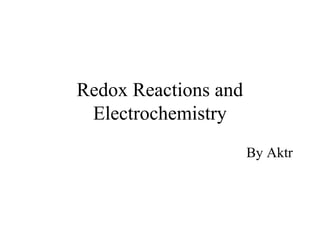
Redox reactions and electrochemistry concepts
- 1. Redox Reactions and Electrochemistry By Aktr book 2
- 4. Loss of e Gain of e Reducing Agent Oxidising agent
- 5. Oxidation
- 6. Reduction
- 7. Electrochemical cell occur both
- 11. SnCl2(aq) + 2FeCl3(aq) → SnCl4(aq) + 2FeCl2(aq) CuO(s) + H2(g) → Cu(s) + H2O(l) Example +2 +3 +4 +2 +1 0 0 +2
- 27. Also act as a conductor
- 36. Metallic conductor depend upon • Nature and structure of metal. • No. of valence electron per atom. • Temperature of the sample.
- 40. conductivity aqueous solution depend upon • Nature of electrolyte. • Size of ion. • Solvation of ion. • Concentration of electrolytic. • Temperature.
- 48. One cell const. and resistivity Known then we can find value Easily.
- 65. Chemical to electrical Electrical to chemical
- 66. 2. Voltaic or Galvanic cells- An electrochemical cell in which a spontaneous reaction produces electricity. Eg. Dry cell, lead storage cell etc.
- 67. 1. Electrolytic cell- An electrochemical cell in which a non spontaneous reaction is forced to occur by passing a direct current from an external source into the solution. Eg. Refining metal(purify), electroplating & production of many chemical substance.
- 68. Gets Smaller -> <- Gets Larger
- 69. Cell Notation 1. Anode 2. Salt Bridge 3. Cathode Anode | Salt Bridge | Cathode | : symbol is used whenever there is a different phase
- 70. 19.2 Cell Notation Zn (s) + Cu2+ (aq) Cu (s) + Zn2+ (aq) [Cu2+ ] = 1 M & [Zn2+ ] = 1 M Zn (s) | Zn2+ (1 M) || Cu2+ (1 M) | Cu (s) anode cathode Zn (s)| Zn+2 (aq, 1M)| K(NO3) (saturated)|Cu+2 (aq, 1M)|Cu(s) anode cathode Salt bridge More detail..
- 71. K(NO3) Zn (s) + 2 H+ (aq) -> H2 (g) + Zn+2 (aq) Zn(s)| Zn+2 |KNO3|H+ (aq)|H2(g)|Pt
- 72. Electrochemical Cells 19.2 The difference in electrical potential between the anode and cathode is called: • cell voltage • electromotive force (emf) • cell potential 0 0 0 reduction oxidation Cell E E E + = UNITS: Volts Volt (V) = Joule (J) Coulomb, C
- 73. Standard Electrode Potentials 19.3 Standard reduction potential (E0 ) is the voltage associated with a reduction reaction at an electrode when all solutes are 1 M and all gases are at 1 atm. Ε0 = 0 V Standard hydrogen electrode (SHE) 2e− + 2Η+ (1 Μ) Η2 (1 atm) Reduction Reaction
- 75. Determining if Redox Reaction is Spontaneous • + E°CELL ; spontaneous reaction • E°CELL = 0; equilibrium • - E°CELL; nonspontaneous reaction More positive E°CELL ; stronger oxidizing agent or more likely to be reduced
- 76. Relating E0 Cell to ∆G0 e ch work ECell arg = Units work, Joule charge, Coulomb Ecell; Volts charge = nF Faraday, F; charge on 1 mole e- F = 96485 C/mole work = (charge)Ecell = -nFEcell ∆G = work (maximum) ∆G = -nFEcell
- 77. Relating Εο CELL to the Equilibrium Constant, K ∆G0 = -RT ln K ∆G0 = -nFE0 cell -RT ln K = -nFE0 cell K nF RT ECell ln 0 = ( ) 0257 . 0 96485 298 31 . 8 = = mole C K molK J F RT K n K n ECell log 0592 . 0 ln 0257 . 0 0 = =
- 80. Effect of Concentration on Cell Potential ∆G =∆G0 + RTlnQ ∆G0 = -nFE0 cell -nFEcell= -nFE0 cell +RTln Q Ecell= E0 cell - RTln Q nF Ecell= E0 cell - 0.0257ln Q n Ecell= E0 cell – 0.0592log Q n
- 81. Corrosion – Deterioration of Metals by Electrochemical Process
- 82. Corrosion – Deterioration of Metals by Electrochemical Process
- 83. Corrosion – Deterioration of Metals by Electrochemical Process
- 86. Abbreviated Standard Reduction Potential Table
- 88. Batteries 19.6 Leclanché cell Dry cell Zn (s) Zn2+ (aq) + 2e- Anode: Cathode: 2NH4 + (aq) + 2MnO2 (s) + 2e- Mn2O3 (s) + 2NH3 (aq) + H2O (l) Zn (s) + 2NH4 (aq) + 2MnO2 (s) Zn2+ (aq) + 2NH3 (aq) + H2O (l) + Mn2O3 (s)
- 89. Batteries Zn(Hg) + 2OH- (aq) ZnO (s) + H2O (l) + 2e- Anode: Cathode: HgO (s) + H2O (l) + 2e- Hg (l) + 2OH- (aq) Zn(Hg) + HgO (s) ZnO (s) + Hg (l) Mercury Battery 19.6
- 90. Batteries 19.6 Anode: Cathode: Lead storage battery PbO2 (s) + 4H+ (aq) + SO4 2- (aq) + 2e- PbSO4 (s) + 2H2O (l) Pb (s) + SO4 2- (aq) PbSO4 (s) + 2e- Pb (s) + PbO2 (s) + 4H+ (aq) + 2SO4 2- (aq) 2PbSO4 (s) + 2H2O (l)
- 91. Fuel Cell vs. Battery • Battery; Energy storage device – Reactant chemicals already in device – Once Chemicals used up; discard (unless rechargeable) • Fuel Cell; Energy conversion device – Won’t work unless reactants supplied – Reactants continuously supplied; products continuously removed
- 92. Fuel Cell A fuel cell is an electrochemical cell that requires a continuous supply of reactants to keep functioning Anode: Cathode: O2 (g) + 2H2O (l) + 4e- 4OH- (aq) 2H2 (g) + 4OH- (aq) 4H2O (l) + 4e- 2H2 (g) + O2 (g) 2H2O (l)
- 93. Types of Electrochemical Cells • Voltaic/Galvanic Cell; Energy released from spontaneous redox reaction can be transformed into electrical energy. • Electrolytic Cell; Electrical energy is used to drive a nonspontaneous redox reaction.
- 95. Faraday’s Constant Redox Eqn Molar Mass Charge =(Current)(Time)